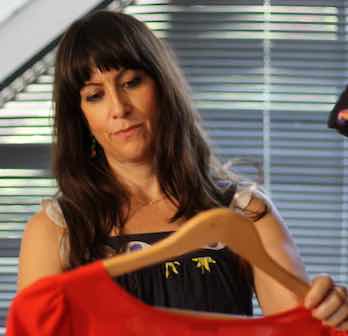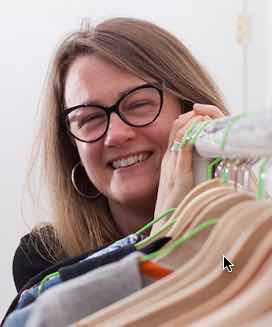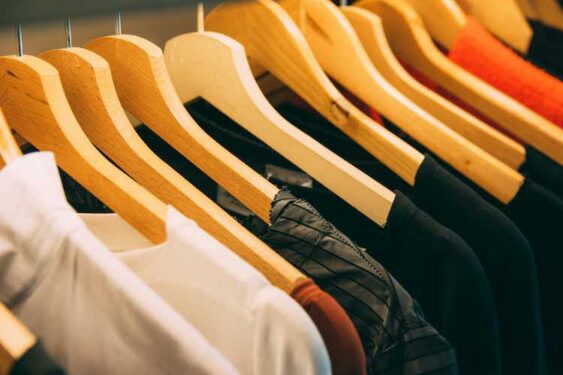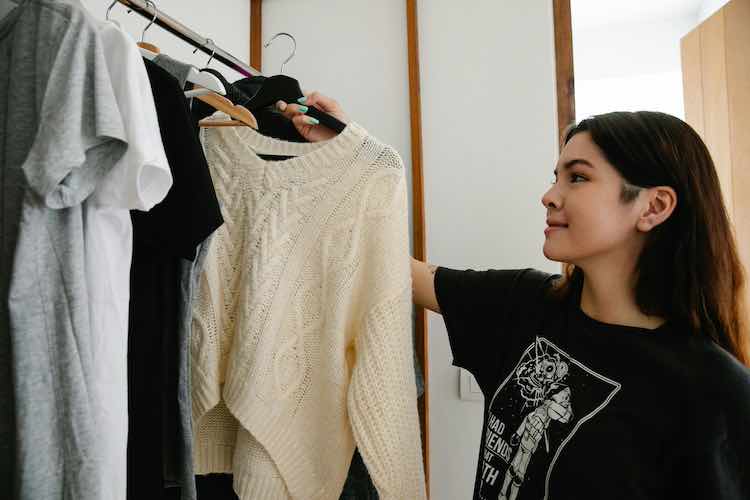We all like a bargain, but some bargains cost more than you’d think.
That’s why some people are turning their back on clothes bargains.
No new clothes in 2023
Kate Hulett is an artist, photographer and small business owner – she has a shop selling homewares, fashion accessories, books and stationery.
She loves clothes, but when she saw images of discarded clothes from first world countries ending up dumped in poorer countries, she found she couldn’t ignore the matter.

So she began to investigate. She found that:
- enormous amounts of clothes go to waste each year, with only a small fraction being recycled;
- the fashion industry is a major contributor to greenhouse gas emissions and to water and land pollution; and
- “most of the people that make our clothes are women and children and they’re paid an absolute pittance in order to make a $20 T-shirt.”
So last year she decided she needed to act. She made a New Year resolution not to buy any clothes for the entire year. She put retail therapy behind her, instead she altered clothes she already had, and was able to get much more wear out of them.
Slow fashion
Jenna Flood is a slow fashion stylist and a fast fashion educator. In 2022 she spent about $10,000 buying more than a hundred items of clothing.
Although she often purchased clothing secondhand, repaired older clothes and purchased ethically, she found she still sometimes sold clothing after just a few wears.
She felt she was succumbing too much to “fast fashion”.

Fast fashion is a trend where people buy items that are fashionable and often cheaper, only to find they only wear the items a few times because the fashion changes. Fast fashion is made worse by fashion influencers on social media promoting “micro trends”.
So, like Kate, Jenna committed to a “wardrobe freeze” in 2023. She’s allowing herself to buy clothing again this year, but she is much more thoughtful about what she buys.
If you want to avoid fast fashion, Jenna suggests:
- do a one month freeze while you re-evaluate;
- keep a track of which items you wear most often, perhaps by taking a photo of your outfit each day; and
- use this information to make more considered choices of clothing that you will wear much more.
Fashion researcher
Wendy Ward is a fashion designer, PhD researcher and author.
Concerned about fast fashion, Wendy keeps a record of every time she wears each item of clothing. She now has a greater appreciation of some of her most worn clothing.
She is an advocate for ethical clothing, and runs workshops helping people learn to love the clothes they already own, and teaching how to make their own clothes using sustainable materials and reducing waste.

Find your own style
Bethany Mynott describes herself as “fashion designer, seamstress, dress maker, and wardrobe fairy godmother!”
She believes we can be more sustainable in our fashion if we develop our own style and not be at the mercy of fashion trends which may not actually suit us.
“I like to tell people that we don’t need a small amount of people doing sustainability perfectly, we need everyone doing it imperfectly,” she says.

Our existing wardrobe is a great place to start, she says, especially the “skinny pile” – clothes that await us losing weight before they can be comfortably worn.
She runs workshops helping people learn how to sew and re-purpose their clothing, saving money, saving the planet and feeling good about the way they look all at the same time.
Slow fashion for men and women
The examples I’ve chosen here are all women, but men can be victims of fast fashion too (I just couldn’t readily find any stories to write about). But the same principles apply:
- Buy less, wear longer
- Quality over quantity
- Timeless style
- Sustainable materials
- Ethical manufacturing
- Maintenance and repair
Christians & fast fashion
Jesus told us to love our neighbours. This includes forced labourers working in unsafe and unhealthy sweat shops.
God has given us stewardship of the world. This requires avoiding wasting resources and polluting the environment.
We can make a stand by following the principles of “slow fashion”.
If you want more facts about the impacts of fast fashion on the planet and the lives of those working in the clothing supply chain, I’ve prepared an outline at Our clothing, justice & creation care.
References
- Clothing industry put on notice as fast fashion and unwanted clothing takes environmental toll. ABC News, Feb 2023.
- Fighting fast fashion by auditing clothes, upcycling the ‘skinny pile’ and doing a wardrobe freeze. ABC news, Mar 2024.
- Experts reveal who’s paying the price for $8 t-shirts. Retail Biz, Aug 2024.
Read more on this site

Our clothing, justice & creation care
Clothing is big business globally, worth about $US 1.7 trillion and creating about 170 billion items each year. But the industry creates problems for the world and some of our poorest fellow humans. Here’s the facts.

Climate change
Five pages outlining the facts established by meteorological science.
Main photo by Timur Weber. Other photos: ABC (Kate Hulett, Wendy Ward), Iconic Minimalist (Jenna Flood), Bethany Alice (Bethany Mynott).

Very true.
I’m not a fashion victim but I have enough clothes to last a lifetime (I hope).
However, I have one question, if we all stop buying cheap clothes then what happens to the livelihoods of the people that make them? Making clothes may be their only source of family income, as small as it is. So if we buy quality goods usually made in first world countries with high incomes does that consign cheap labour and their products to the scrapheap?
I agree we all buy too many clothes for our needs, but there will be collateral damage from a cheap clothes boycott.
It’s a good question, and I don’t think we can totally avoid some of the problems you outline. But I think there are several problems with fast fashionj, and they require several different responses.
1. There is an environmental problem, in both manufacture and waste. I think we reduce that by buying less.
2. There is a human exploitation problem when producers pay low wages and provide unsafe conditions. I think we can reduce that by buying ethically. There are guides to ethical clothing and following them will send the money to those who pay more. If we are keen, we can also write to less ethical clothing brands and tell them what we are doing, to influence them. In addition, we can support government action to hold companies accountable for slavery in their manufacturing. All of this should help move brands towards fairer working conditions. Though I admit there will be some adverse affects on some people too – that is part of the wealth imbalance in the world, which needs addressing in other ways.
3. We have a problem too if we accumulate excessive clothing (or anything else), but that is a more general issue. I believe there are ways to address it, but I don’t expect much change any time soon! :(.
Very sage advice that everyone should follow.
Thank you.